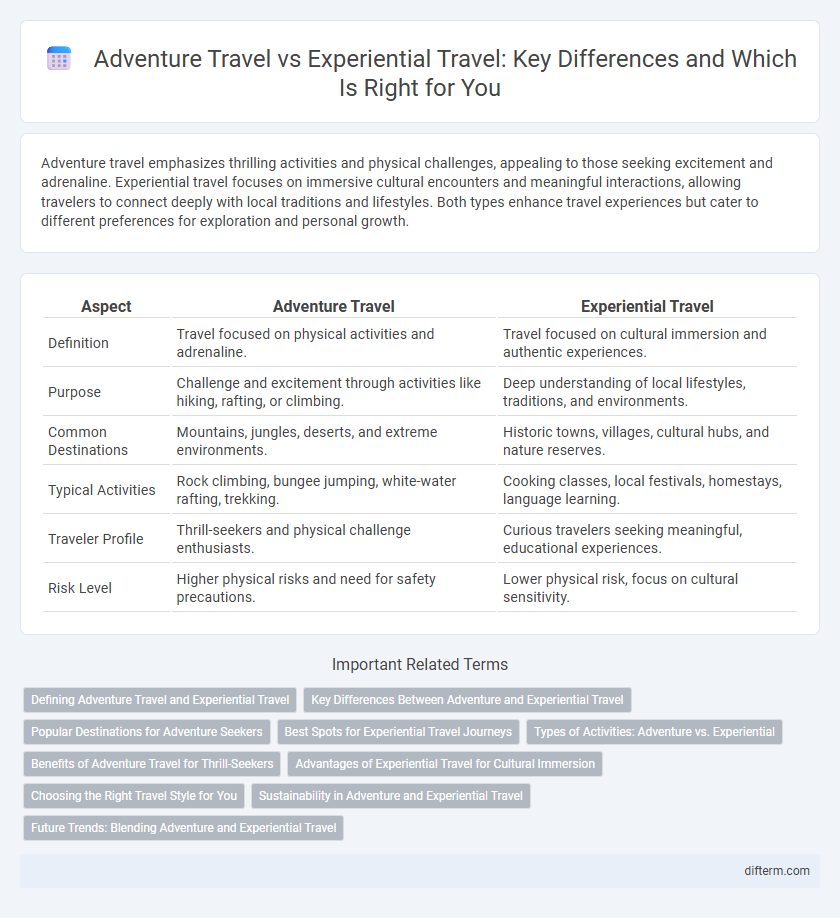Adventure travel emphasizes thrilling activities and physical challenges, appealing to those seeking excitement and adrenaline. Experiential travel focuses on immersive cultural encounters and meaningful interactions, allowing travelers to connect deeply with local traditions and lifestyles. Both types enhance travel experiences but cater to different preferences for exploration and personal growth.
Table of Comparison
| Aspect | Adventure Travel | Experiential Travel |
|---|---|---|
| Definition | Travel focused on physical activities and adrenaline. | Travel focused on cultural immersion and authentic experiences. |
| Purpose | Challenge and excitement through activities like hiking, rafting, or climbing. | Deep understanding of local lifestyles, traditions, and environments. |
| Common Destinations | Mountains, jungles, deserts, and extreme environments. | Historic towns, villages, cultural hubs, and nature reserves. |
| Typical Activities | Rock climbing, bungee jumping, white-water rafting, trekking. | Cooking classes, local festivals, homestays, language learning. |
| Traveler Profile | Thrill-seekers and physical challenge enthusiasts. | Curious travelers seeking meaningful, educational experiences. |
| Risk Level | Higher physical risks and need for safety precautions. | Lower physical risk, focus on cultural sensitivity. |
Defining Adventure Travel and Experiential Travel
Adventure travel involves engaging in physically challenging or adrenaline-pumping activities like hiking, rock climbing, or white-water rafting, emphasizing thrill and risk. Experiential travel centers on immersive cultural experiences, such as local cooking classes, traditional ceremonies, or community interactions, prioritizing deeper understanding over physical exertion. Both travel styles offer unique ways to connect with destinations but differ in focus on activity intensity versus cultural engagement.
Key Differences Between Adventure and Experiential Travel
Adventure travel emphasizes physical challenges and adrenaline-pumping activities such as hiking, rafting, or mountain biking, targeting thrill-seekers who crave excitement and risk. Experiential travel focuses on immersive cultural experiences, local interactions, and meaningful learning opportunities, appealing to travelers seeking deeper understanding of traditions and lifestyles. Key differences revolve around the intensity of physical activity in adventure travel versus the cultural engagement and personal growth emphasized in experiential travel.
Popular Destinations for Adventure Seekers
Popular destinations for adventure seekers include New Zealand, known for its bungee jumping and white-water rafting, and Costa Rica, famous for zip-lining through rainforests and surfing world-class waves. Patagonia offers unparalleled trekking and glacier exploration, attracting travelers seeking physical challenges in stunning landscapes. These locations provide immersive experiences that combine adrenaline-fueled activities with deep cultural engagement, making them top picks for adventure travel enthusiasts.
Best Spots for Experiential Travel Journeys
Experiential travel centers on immersive cultural interactions, with top destinations including Kyoto for its traditional tea ceremonies, Rajasthan's desert villages for authentic tribal experiences, and Peru's Sacred Valley for Andean community visits. These locations offer deep engagement with local customs, crafts, and cuisines, enriching travelers beyond typical sightseeing. Choosing destinations known for vibrant cultural heritage ensures meaningful and transformative travel experiences.
Types of Activities: Adventure vs. Experiential
Adventure travel includes high-energy activities such as rock climbing, white-water rafting, and mountain biking that emphasize physical challenge and adrenaline rush. Experiential travel focuses on immersive cultural experiences like cooking classes, local festivals, and artisan workshops, offering deeper engagement with the destination's traditions. Both travel types provide unique opportunities, with adventure prioritizing thrill-seeking and experiential centering on meaningful interactions.
Benefits of Adventure Travel for Thrill-Seekers
Adventure travel offers unparalleled excitement for thrill-seekers by providing activities like rock climbing, white-water rafting, and bungee jumping in diverse natural landscapes. This type of travel enhances physical fitness, mental resilience, and fosters a deep connection with nature while pushing personal boundaries. Immersing in adrenaline-pumping experiences creates lasting memories and a unique sense of achievement unmatched by conventional travel forms.
Advantages of Experiential Travel for Cultural Immersion
Experiential travel offers deep cultural immersion by allowing travelers to engage directly with local customs, traditions, and daily life, fostering genuine connections and understanding. Unlike adventure travel, which often emphasizes physical challenges and adrenaline-pumping activities, experiential travel emphasizes learning through participation, such as cooking local cuisine or attending traditional ceremonies. This immersive approach enriches travelers' perspectives and creates meaningful memories rooted in authentic cultural experiences.
Choosing the Right Travel Style for You
Adventure travel emphasizes thrilling activities like hiking, whitewater rafting, and mountain climbing that challenge physical limits and foster adrenaline rushes. Experiential travel centers on deep cultural immersion, allowing travelers to connect with local traditions, cuisines, and lifestyles for meaningful memories. Selecting the right travel style depends on personal interests, desired level of physical activity, and the type of experiences one values most during the journey.
Sustainability in Adventure and Experiential Travel
Adventure travel emphasizes physical challenges in natural settings, often promoting conservation through eco-friendly practices and responsible tourism to minimize environmental impact. Experiential travel prioritizes cultural immersion and sustainable interactions with local communities, fostering social and economic benefits while preserving heritage. Both travel types support sustainability by encouraging travelers to respect ecosystems and contribute to the longevity of destinations.
Future Trends: Blending Adventure and Experiential Travel
Future trends in travel emphasize the seamless integration of adventure travel and experiential travel, creating immersive journeys that combine physical challenges with cultural and sensory engagement. Travelers increasingly seek personalized experiences that offer both adrenaline-fueled activities and authentic connections with local communities, driving innovation in tour design and technology-led customization. This fusion enhances sustainability and promotes responsible tourism by encouraging deeper understanding and respect for destinations while satisfying the growing demand for meaningful, transformative travel.
Adventure travel vs Experiential travel Infographic

 difterm.com
difterm.com